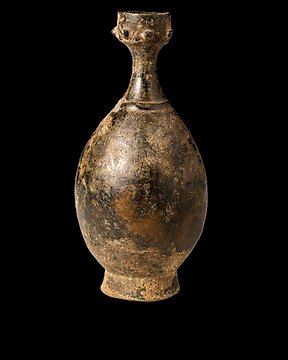
Chorasan Bronzeflasche (Ohne Mindestpreis)
Nr. 83878337

Nr. 83878337

Achaemenid style Aubergine Glass Rhyton with Ram's Head
style of the 5th century BC
This unique drinking vessel features the forepart of a ram's body, including forelegs, snout, eyes, and curved horns. The cup flares with ribbed vertical features on the outside.
The Achaemenid Dynasty was an ancient Persian dynasty that ruled over a vast empire from approximately 550 BC to 330 BC. Founded by Cyrus the Great, the Achaemenid Empire extended from Anatolia and Egypt in the west to the Indus Valley in the east, encompassing numerous regions and diverse cultures.
Under the Achaemenid rule, the empire achieved unprecedented levels of political organization, economic prosperity, and cultural exchange. It is known for its efficient administrative systems, including the use of satrapies or provinces governed by satraps, and the construction of the Royal Road, facilitating communication and trade across the empire.
One of the most famous and influential rulers of the Achaemenid Dynasty was Darius I, who expanded the empire to its greatest extent and undertook ambitious construction projects, including the construction of the Persian capital city of Persepolis.
The Achaemenid Dynasty left a lasting legacy in the form of its architectural achievements, such as the monumental palaces and tombs at Persepolis, as well as its cultural contributions, including the development of the Old Persian language and the adoption of Zoroastrianism as the state religion.
The dynasty came to an end following the conquests of Alexander the Great, who defeated the last Achaemenid ruler, Darius III, in 330 BC, marking the beginning of the Hellenistic period in the Near East. Despite its eventual decline, the Achaemenid Dynasty remains a significant and influential era in ancient history, shaping the course of the ancient world for centuries to come.
Dimensions: 100mm x 180mm; weight 180g
Provenance: Private UK Ancient Art Collection formerly acquired on the UK, European, and USA Art Markets from pre-2000 Collections.
Disclaimer:
NO SHIPPING OUTSIDE OF THE EUROPEAN UNION.
All items will be shipped from Belgium.
The seller guarantees and can prove that the object was obtained legally.
The seller was informed by Catawiki that they had to provide the documentation required by the laws and regulations in their country of residence.
The seller guarantees and is entitled to sell/export this object.
The seller will provide all provenance information known about the object to the buyer.
The seller ensures that any necessary permits are/will be arranged.
The seller will inform the buyer immediately about any delays in obtaining such permits.
The seller will not ship outside the EU.
So kaufen Sie auf Catawiki
1. Etwas Besonderes entdecken
2. Höchstgebot abgeben
3. Sichere Zahlung durchführen